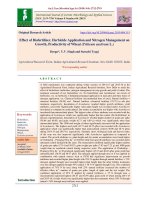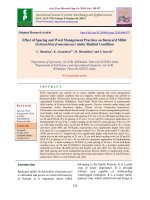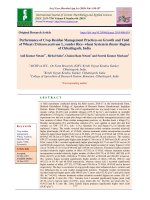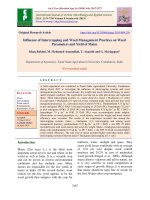Influence of weed management practices on productivity of wheat (Triticum aestivum L.) under middle indo-gangetic plains of Eastern India
Bạn đang xem bản rút gọn của tài liệu. Xem và tải ngay bản đầy đủ của tài liệu tại đây (150.31 KB, 6 trang )
Int.J.Curr.Microbiol.App.Sci (2017) 6(6): 2486-2491
International Journal of Current Microbiology and Applied Sciences
ISSN: 2319-7706 Volume 6 Number 6 (2017) pp. 2486-2491
Journal homepage:
Original Research Article
/>
Influence of Weed Management Practices on Productivity of Wheat
(Triticum aestivum L.) under Middle Indo-Gangetic Plains of Eastern India
Ajit Kumar Paswan1, Devendra Mandal2, Jeetendra Kumar3 and Rakesh Kumar4*
1
Agronomy, KVK Jehanabad, BAU Sabour-813 210, India
Agronomy, 3Agricultural Engineering, KVK Bikramganj, BAU Sabour-813 210, India
4
Division of Crop Research, ICAR Research Complex for Eastern Region, Patna-800 014, India
2
*Corresponding author
ABSTRACT
Keywords
Weed
management,
Wheat,
Sulfosulfuron,
Herbicide mixture,
Yield.
Article Info
Accepted:
29 May 2017
Available Online:
10 June 2017
A field experiment was conducted during the rabi season of 2013-14 and 2014-15 at
farmer’s field of Krishi Vigyan Kendra, Jehanabad, Bihar to evaluate the effect of weed
management practices on productivity and profitability of wheat. The treatments were
comprised of four weed management practices i.e. control or farmer practices,
sulfosulfuron 25 g a.i./ha, metsulfuron-methyl 4 g a.i./ha and premix of sulfosulfuron and
metsulfuron methyl (30+2) g a.i./ha, laid out in randomized block design and replicated
five times. Results revealed that application of sulfosulfuron and metsulfuron-methyl
(30+2) g a.i. /ha produced significantly higher grain yield (3868 kg/ha) but being on a with
sulfosulfuron 25 g a.i. /ha (3818 q/ha). The lowest grain yield was recorded with the
farmers practices (2576 kg/ha). Further, markedly higher weed dry weight (138 g/m 2) was
recorded with control and lowest with application of premix formulation of sulfosulfuron
and metsulfuron methyl (40 g/m2). Hence, it may be concluded that application of premix
sulfosulfuron and metsulfuron methyl (40 g/m2) is beneficial in achieving the higher
productivity and profitability of wheat for the farming community of Eastern India.
Introduction
During the last four decades, wheat
production and productivity increased almost
six times in India and its alone contributes
~1/3rd of total food grain production (Bohra
and Kumar, 2014). Area under wheat was
increased since start of Green revolution in
1967 and production and productivity were
also increased. In this period, production has
also increased from 11.4 to 88.3 mt and
productivity has gone up 887 kg ha-1 to 3140
kg ha-1 (Maurya et al.2014). This crop has a
global significance because of the staple food
of millions of people and supplies ~20% of
the food calories for world's growing
population. In India, it is the 2nd staple food
crop next to rice having an annual production
of 95.91 mt from 29.7 m ha (Kumar et
al.2016).
Though wheat is an important cereal crop in
India, its productivity is lower as compared to
other wheat growing countries of the world
(Jeet et al 2010a, b, c). A formidable factor
that limits its productivity is severe weed
competition during the initial crop growth
stages. Continuous cultivation of dwarf wheat
in rice-wheat system has led to perceptible
change in weed flora. Further, the continuous
and appropriate use of isoproturon since 1978
has caused shift in weed flora and
2486
Int.J.Curr.Microbiol.App.Sci (2017) 6(6): 2486-2491
development of resistance in Phalaris minor
to the herbicides (Singh et al., 2011a).
The dominant weed flora in wheat consists of
both grassy and broad leaf weeds i.e. Phalaris
minor, Avena spp., Chenopodium album,
Melilotus spp., Anagallis arvensis, Vicia
sativa, Lathyrus aphaca and Rumex dentatus
etc. In recent years, a new species Rumex spp.
has emerged as serious problem in irrigated
wheat eco-system. Therefore, complexity and
diversity of weed flora requires more than one
herbicide either in sequence or as mixture for
their management. Thus, it is imperative to
screen the herbicides, with alternate mode of
action for effective weed control and to
ensure the better yield. Significant reduction
in wheat yield ranging from 18-73% due to
severe infestation of weeds has been reported
by Pandey and Verma (2004).
Many sulphonylurea herbicides have been
more and more used in wheat due to their low
application rate and less persistence in
environment (Singh et al.2011b). The
availability and recommendations of selective
herbicides
including
metaxuron,
methabonzthrazuron,
isoproturon,
and
diclofopmethyl made it possible to realize
potential yield of wheat. The use of new
alternate herbicides including sulfosulfuron
was recommended, which provides a great
relief to wheat crop from resistant population
of P. minor. Therefore, keeping these facts in
mind and importance of problems from the
national point, the present front line
demonstration was conducted to find out the
efficacy of sulfosulfuron against complex
weed flora and wheat yield.
Materials and Methods
An experiment was conducted during the rabi
season of 2013-14 and 2014-15 at farmers
field of Krishi Vigyan Kendra, Jehanabad,
Bihar to study the efficacy of sulfosulfuron in
weed management practices on wheat. The
mechanical analysis of soil showed that
textural class of experimental plot was sandy
loam, while chemical analysis indicated that
soil reaction slightly alkaline i.e. 6.64 and
electrical conductivity were normal (0.02
ds/m). Soil was found to be low in organic
carbon (0.46%), available nitrogen (263
kg/ha) and available phosphorus (9.46 kg/ha).
The crop was sown with the seed rate of 100
kg/ha and row spacing of 20 cm was
maintained for optimum plant population and
fertilized with recommended dose of fertilizer
of 160, 60 and 40 kg/ha of N, P2O5 and K2O,
respectively through urea, di-ammonium
phosphate (DAP) and muriate of potash
(MOP).
Half dose of N and full dose of P2O5 and K2O
was applied as basal and rest doses of
nitrogen were applied in two equal splits at
maximum tillering and panicle initiation
stages. First irrigation was given at crown
root initiation (CRI) stage (21 DAS) and then
applied as per crop requirement. All the
herbicides of sulfosulfuron groups were
applied as a post -emergence at 60 DAS with
manually operated
Knapsack
sprayer
delivering a spray volume of 600 liter/ha
through flat-fan nozzle. For recording the
biometric observation, plants were tagged
randomly in net plots.
The harvested total dry matter production was
weighed in field with the help of spring
balance and noted separately. Each plot
material threshed separately with the help of
thresher and for removed of inert material.
Data were recorded on following parameters
of growth, yield attributes and yields viz, no.
of tillers, 1000-grain weight, grain, straw and
biological yields as per the standard
procedure. The field data obtained for 2 years
were pooled and statistically analyzed using
F-test (Gomez and Gomez, 1984). Test of
significance of the treatment differences were
2487
Int.J.Curr.Microbiol.App.Sci (2017) 6(6): 2486-2491
done on the basis of t-test. The significant
difference between treatment means were
compared with critical differences at 5%
levels of probability.
Results and Discussion
The experimental field was infested mainly
with grassy and broad leaf weeds during both
the years. The dominant weeds flora in
experimental field were Cynodon dactylon,
Cyperus rotundus, Anagallis arvensis and
Convolvulus arvensis, which constituted 41.4,
20.4, 10.4 and 13.8%, respectively under
farmers’ practices at 60 days stage of crop
growth.
Application
of
different
doses
of
sulfosulfuron resulted into significantly lower
weed dry weight as compared to the farmer’s
practices. The maximum reduction in weed
dry weight (70.3 g/m2) was recorded with
application of sulfosulfuron and metsulfuron
methyl (30+2) g a.i./ha at 60 DAS, which was
found to be significantly superior over rest of
the treatments. The maximum weed dry
weight (139.7 g/m2) was associated with the
farmer’s practices. Different dose of
sulfosulfuron reduced weed control efficiency
to the extent of 98.7% (Table 2).
Singh et al., (2010a) also reported that
sulfosulfuron has been reported to be very
effective against the grassy weeds and to
some extent against BLWs. Similarly, weed
control efficiency (WCE) was also influenced
markedly with application of herbicides.
Premix application of sulfosulfuron and
metsulfuron methyl (30+2) g a.i./ha at 60
DAS was the highest weed control efficiency
as compared to rest of the treatments.
However, the lowest WCE was associated
with control. This might be due to application
of herbicide stunted the growth of weed with
the respective treatments.
The yield attributes of wheat were markedly
influenced by different weed management
practices. The yield attributes i.e. tillers/m
row was recorded significantly higher with
mixture of sulfosulfuron and metsulfuron
methyl (30+2) g a.i./ha but being at par with
mixture. However, the reverse trends were
followed in case of 1000-grain weight, where
these attributes was recorded higher with
sulfosulfuron (38.8 g). This is attributed to
higher dry matter production was associated
with the crop, which leads to higher number
of grains/spike and test weight. This might be
due to better weed control efficiency
associated, which ultimately caused the
higher yield attributes in wheat (Singh et al.,
2011b). Similar line of confirmation has been
reported by Lalji et al., (2013) (Table 1).
Application of sulfosulfuron significantly
increased grain yield over the farmer’s
practices. Application of premix of
sulfosulfuron and metsulfuron methyl (30+2)
g a.i./ha increased grain yield of wheat to the
tune of 51.2% over the farmers practices.
Higher grain yield in herbicide treatments was
due to the better weed control, which gave
reduction in weed dry matter as compared to
unweeded control thus, resulting in better
crop development including tillering, dry
matter production and grain formation there
by favoring the grain yield. Further, straw and
biological yield crop followed the similar
trend.
Significantly higher crop productivity (29.76
kg/ha/day) was recorded premix application
of sulfosulfuron and metsulfuron methyl but
being on a par with sulfosulfuron (29.37
kg/ha/day). This might be due to the higher
yield associated with the respective
treatments.
2488
Int.J.Curr.Microbiol.App.Sci (2017) 6(6): 2486-2491
Table.1 Effect of weed management practices on yields attributes and yields of wheat (Pooled data of two years)
Treatment
Farmers Practices
2,4-D
Metsulfuron methyl
Sulfosulfuron
Mixture
SE±M
CD (P=0.05)
Tillers/m
row (no.)
39.47
51.53
52.67
57.12
62.41
5.09
15.27
Grains/
spike (no.)
25.67
32.53
35.03
40.62
41.79
0.59
1.76
1000-grain
weight (g)
36.61
36.50
36.81
38.33
38.84
0.54
1.61
Grain yield
(kg/ha)
2576
2969
3098
3818
3868
54
162
Straw yield
(kg/ha)
3432
3957
4128
5088
5155
117.21
351.38
Biological
yield (kg/ha)
6008
6926
7226
8906
9023
313
1239
Crop Productivity
(kg/ha/day)
19.81
22.84
23.83
29.37
29.76
0.42
1.25
Table.2 Effect of weed management practices on weed control efficiency and economics of wheat (Pooled data of two years)
Treatment
Farmers Practices
2,4-D
Metsulfuron methyl
Sulfosulfuron
Mixture
SE±M
CD (P=0.05)
Weed dry weight
(g/m2) at 60 DAS
139.7
113.6
108.1
83.0
70.3
1.33
3.98
WCE (%)
at 60 DAS
23.0
29.2
68.3
98.7
-
Gross returns
(Rs./ha)
39920
46026
48014
59176
59959
841
2523
*WCE: Weed control efficiency, DAS: Days after sowing
2489
Net returns
(Rs./ha)
17244
22627
24565
34902
35935
841
2523
Benefit:
cost ratio
1.76
1.97
2.05
2.44
2.50
0.03
0.10
Economic efficiency
(Rs./ha/day)
133
174
189
268
276
6.4
19.4
Int.J.Curr.Microbiol.App.Sci (2017) 6(6): 2486-2491
Economic attributes of wheat were influenced
markedly with weed management practices.
Significantly
higher
gross
returns
(Rs.59959/ha), net returns (Rs.35935/ha), and
benefit: cost ratio (2.50) were recorded
significantly higher with mixture of
sulfosulfuron and metsulfuron methyl (30+2)
g a.i./ha but being noted at par with mixture
of sulfosulfuron. Similarly, economic
efficiency recorded significantly higher with
application of herbicides mixture (276
kg/ha/day) over rest of the treatment but being
on a par with sulfosulfuron and metsulfuron
methyl (30+2) g a.i./ha. These values were
recorded the lowest with the farmer’s
practices (133 kg/ha/day). This might be due
to higher yield associated and comparatively
lower cost of production with the respective
treatment (Singh et al.2010b). The similar
findings have been reported by Yadav et al.,
(2013) and Paswan et al., (2012).
Hence, in this trial best efficacy of total weed
biomass control and maximize the yield
potential with the application of herbicide
premix of sulfosulfuron and metsulfuron
methyl (30+2) g a.i./ha were achieved highest
as compared to separate application of
sulfosulfuron and metsulfuron–methyl alone.
Therefore, it may be a valid approach to
improve the productivity and profitability of
wheat in irrigated ecosystem in middle IndoGangetic plains of Eastern India.
References
Bohra JS and Kumar R.2015. Effect of crop
establishment methods on productivity,
profitability and energetics of rice
(Oryza
sativa)-wheat
(Triticum
aestivum) system. Indian Journal of
Agricultural Sciences 85 (2): 217-223.
Gomez,
K.A.
and
Gomez,
A.A.1984.Statistical Procedure for
Agricultural Research, 2nd Edn. John
Wiley and Sons, New York. Pp. 241271, 1984.
Jeet S, Kler DS, Kumar R and Kumari
A.2010a.Response of seed rates and
nitrogen levels in relation to crop
residue
management
on
microenvironment of bed planted
soybean (Glycine max)-wheat (Triticum
aestivum) system. Environment and
Ecology 28 (3):1571-1576.
Jeet S, Saini KS, Kumar R and Kumari
A.2010b.Effect of seed rates and
nitrogen levels in relation to crop
residue management on growth and
yield of soybean and wheat in bed
planted soybean (Glycine max)-wheat
(Triticum
aestivum)
system.
Environment and Ecology 28 (3):15531557.
Jeet S, Singh D, Kumar R and Kumari
A.2010c.Yield and physico-chemical
properties of soil as affected by seeding
rates and nitrogen levels in relation to
crop residue management on bed
planted soybean (Glycine max)-wheat
(Triticum
aestivum)
system.
Environment
and
Ecology
28
(3B):2063-2067.
Kumar S, Dwivedi SK, Kumar R, Mishra JS,
Singh SK, Prakash V, Rao KK and
Bhatt BP.2017.Productivity and energy
use efficiency of wheat (Triticum
aestivum) genotypes under different
tillage options in rainfed ecosystem of
middle Indo-Gangetic Plains. Indian
Journal of Agronomy 62 (1): In Press.
Maurya P, Kumar V, Maurya KK, Kumawat
N, Kumar R and Yadav MP.2014.Effect
of potassium application on growth and
yield of wheat varieties. The Bioscan 9
(4): 1371-1373.
Pandey A. K., K. A. Gopinath and H. S.
Gupta.
2006.
Evaluation
of
sulfosulfuron and metribuzin for weed
control in irrigated wheat. Ind. J. Agron.
51: 135-138.
2490
Int.J.Curr.Microbiol.App.Sci (2017) 6(6): 2486-2491
Paswan AK, Kumar R, Kumar P and Singh
RK.2012. Influence of metsulfuronmethyl and carfentrazone-ethyl either
alone or in combination on weed flora,
crop growth and yield in wheat
(Triticum
aestivum).
Madras
Agricultural Journal 99 (7-9):560-562.
Singh AK, Kumar R, Singh AK, Kumari
A.2011a.Bio-efficacy of sulfosulfuron
on weed flora and irrigated wheat
(Triticum
aestivum
L.)
yield.
Environment and Ecology 29 (2A):834838.
Singh AK, Kumar R, Singh AK, Singh NK
and Kumari A. 2011b.Performance of
sulfosulfuron against weeds in irrigated
wheat
(Triticum
aestivum
L.).
Environment and Ecology 29 (2A):831833.
Singh S, Yadav RA, Kumar R and Verma
SS.2014.Influence of herbicides against
weeds associated with wheat (Triticum
aestivum L.). Bioinfolet 11 (3B): 855857.
Yadav L, Sharma J, Singh AK, Kumar R,
Meena
RN
and
Choudhary
HR.2013.Efficacy of 2, 4-D herbicide
application on growth, yield and spike
deformities in late sown wheat varieties
in Eastern Uttar Pradesh. Madras
Agricultural Journal 100 (1-3):135-138.
How to cite this article:
Ajit Kumar Paswan, Devendra Mandal, Jeetendra Kumar and Rakesh Kumar. 2017. Influence
of Weed Management Practices on Productivity of Wheat (Triticum aestivum L.) under Middle
Indo-Gangetic Plains of Eastern India. Int.J.Curr.Microbiol.App.Sci. 6(6): 2486-2491.
doi: />
2491









